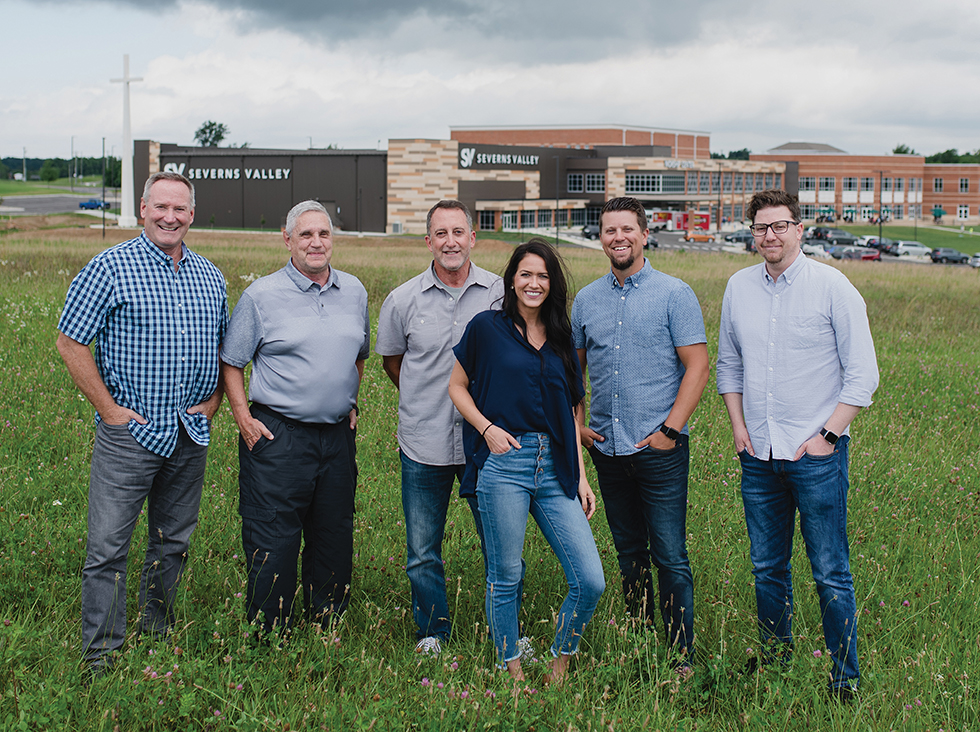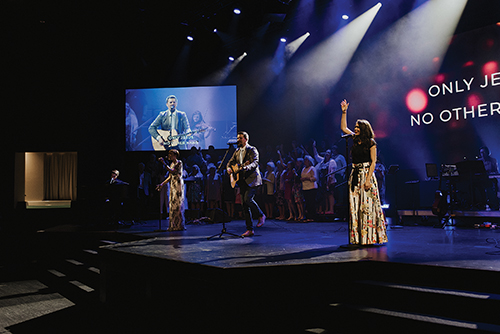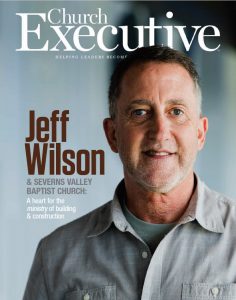
Jeff Wilson & Severns Valley Baptist Church
By RaeAnn Slaybaugh
In 2007, when Severns Valley Baptist Church relocated to its current property in Elizabethtown, Kentucky, it was a major move. After all, this congregation (established in 1781) is older than the United States Constitution itself and was attended by Abraham Lincoln’s grandparents — also, very possibly, Lincoln himself, who was born just 15 minutes away.
When the church embarked on a second, even more extensive $16.5-million building project in 2016, a steady hand was at the helm: Executive Pastor Jeff Wilson. Having quite a bit of familiarity with the chosen construction method — design/build — he was a big advocate.
His reasons are clear: this huge project finished on time and under budget, all with an expanded scope. It even became a ministry opportunity for the church.

As with so many church building projects, not everything went as expected for Severns Valley Baptist Church (SV) during its relocation several years ago.
Plans had been drawn up, but the bids came back significantly over budget. Tough decisions were made, and the church built only what it could afford at the time: education space, an atrium, kitchen, fellowship hall and double-gymnasium. Noticeably absent was a dedicated worship center; instead, services were held in the double-gymnasium with hardwood floors. Every week, chairs were set up and torn down. Every. Week.
When the loan on those facilities was paid off in May 2016, leaders at SV understandably set their sights on something they didn’t yet have: a high-tech, energy-efficient, concert-quality 1,400-seat worship center.
Fortunately, it wasn’t Executive Pastor Jeff Wilson’s first major building project. Having worked construction during college, he had some background in the nuts-and-bolts. Wilson even planned on being an architect at one time.
In 2011, Senior Pastor Bill Langley reached out to Wilson — who he’d worked with at a church in Oklahoma — to ask if he might know someone to fill a family pastor role. In their discussions, Wilson suggested that what Langley really seemed to need was an executive pastor. He came to Kentucky to consult the Search Team. A few weeks later, Langley had identified the ideal candidate: Wilson himself!
“I’m really privileged to work with a great friend,” he said of Langley. “Though he knew I had prior experience, the trust that he’s given to me is pretty crazy, honestly. He allows me to be me, and he allows me to use my gifts and talents, and abilities.”
And yes, Wilson’s interest in and familiarity with building and construction was no doubt appealing at that moment in the church’s history. This passion has served Wilson (and his churches) well throughout his 37-year ministry career. As a 21-year-old student pastor and recreation pastor, he came alongside the senior pastor of his first church to spearhead a Family Life Center project. At many churches since, he has been involved in remodeling projects. He also served on the building team at his last church in 2005.
Through all these projects, Wilson said, he developed a preference for the design/build method, with its focus on strong subcontractor relationships and truer build cost.
“You’re determining who the good subcontractors are by bidding out the different specific parts of the construction, from HVAC, to electric, to plumbing, to dirt work,” he explained. “You’ve got all the different players involved in the game, working together, instead of working independently.”
“We believed we’d get a better facility, better renovation and outdoor community space — and save money in the process — through design/build,” Wilson said.
A big vision requires the right partner
Those are some big expectations for a $16.5-million building project, its crown jewel being the new 1,400-seat worship center. It would have two lobbies (upstairs and downstairs) and a double hallway connecting it to the old facilities, letting worshippers enter the sanctuary from the first or second floor.
Other project elements included a partial renovation of the SVkids and SVstudent areas; an 80-foot cross; handicapped and senior adult parking areas; and — importantly — development of The Lawn, a vast outdoor commons space.
The search was on for the unique firm that would spearhead this ambitious effort for SV, all with an 18-month project timeline. Three different design/build firms were interviewed. As Wilson explained, what made Visioneering Studios stand out — a nationally licensed Architectural and Construction firm with offices in Santa Ana, Dallas, Nashville, and Charlotte — was “how they listened” to the building team.
“That may sound strange, but they truly heard our desires and didn’t try to make them fit into their preconceived ideas or model,” Wilson recalled. “They also helped us to think about options outside of our own preconceived ideas and models.”
Key to the church’s project vision is the ability to connect with the community and become a regional church. In particular, Visioneering was candid about the ways in which the existing SV campus did not support that objective.
“They were just very upfront,” Wilson recalled. “They said, ‘Your buildings are brick-and-mortar, very traditional. People told us it looks like a college campus, a federal building, a library. And you can’t see the main entrance from the two major roads that go by the property.’”
“They said, ‘You need to have a face that faces the community, instead of the rear of your building facing the community,’” he added. “And that left an impression on us. A good impression.”

The “dream session” becomes reality
With the right building partner onboard, the next step was a “Blue Sky Workshop,” a master-planning session conducted between Visioneering and the church in November 2015. The building team, some ministerial staff, and even some plugged-in church members were invited.
“It was kind of a dream session,” Wilson recalled. “This was where Visioneering heard our heart and helped to put it on paper.”
After “a million questions” were asked, participants were broken into groups and brought back together to share. A conceptual design was formulated, the scope determined, and the projected budget discussed.
At the end of the day, Visioneering did a presentation. Then — literally overnight — their team returned with a much more comprehensive picture of the project. It demonstrated a conceptual design, not just of buildings, but also as a master plan for all of SV’s 70 acres of land and current facilities.
“They helped us to think way beyond the worship center,” Wilson said. As a result, added-scope items included 45 more parking spaces, replacement of all sodium outdoor lighting in parking and entry roads with energy-efficient LED lights, and added exterior / interior aesthetic lighting. In terms of impact, the latter has been especially important.
A new, 80-foot cross and two hallways face the community. Powered by energy-efficient LED, RGBW lights, both the cross and hallways can be lit in different colors, which is especially impactful at night. For Good Friday, the hallways and cross were lit red. For Easter Sunday, as people arrived for services while it was still dark outside, all three were lit purple.
 “The community has just raved about it,” Wilson said. “We’ve become a landmark.”
“The community has just raved about it,” Wilson said. “We’ve become a landmark.”
Visual impact is one thing, of course; if those changes can come at a cost savings, then you’re really onto something. And that’s exactly what happened at SV: in the end, the project came in more than $500,000 under budget, including the added-scope items. Those savings funded a new sound system and an LED wall, to name a few upgrades.
And, as part of the design/build process — working closely with subcontractors, that is — SV is seeing a 75-percent reduction in heating and cooling costs. “We’re already seeing a savings to cover the cost of our LED lighting and exterior LED lighting around the building,” Wilson explained.
He further credited Visioneering for going above and beyond to keep the project within budget. This included working with a steel company to pre-purchase materials and lock in the price, which saved about $75,000.
All those cost savings have meant a lot for SV’s ministry, not the least of which that the debt will get paid off faster. “That’s money that can go straight into ministries that we have,” Wilson said.
On the relationships side, Wilson said SV considered the project more than a construction process; it was a mission field. The church hosted five free lunches for the laborers throughout the building process, which helped to build incredible fellowship.
“I can’t tell you how many times I’d walk through the building, and guys I’d gotten to know — brick layers, dirt workers, electricians, plumbers, drywall guys — would stop me and say, ‘Hey, I’m going through this. Can you pray for me?’” Wilson recalled. “And because of that relationship, they were also trying to help us build the best building that we could for the least amount of money. By all of us working together, God just united hearts in this.”
A community calling card
In keeping with the church’s goal to be a community church, perhaps no element of the project speaks as loudly as The Lawn, three acres of pristinely maintained outdoor event space.
Lunch on the Lawn — currently in its third month — has proven particularly effective. Along with hosting games, the church’s roastery is on hand selling coffee, along with numerous food trucks. “They’ve nearly sold out of food because of the number of people that were coming,” Wilson said. “It’s been really cool.”

Many of the patrons are guests of church members, be they coworkers, friends or family. According to Wilson, two sisters — employees of the church — had been praying for a third sister to come. Invite after invite, she always said no. But she did come to the first Lunch on the Lawn and had a great time. Since then, she has involved her granddaughter in preschool activities at the church and returned for another lunch. “She’d never stepped on our property before that,” Wilson said.
Another member — a deacon — kept trying (and failing) to get his coworkers to come to church. He succeeded in getting them to try out a Lunch on the Lawn, though. One — though he’d had a great time that day — still asserted that the church was “way too big” for him to feel comfortable there. After an impromptu walk-through of the facilities, however, he said, “I think I’ll be back.”
Right now, SV is enrolling for a camp for children with disabilities, which it will host on its grounds.
Additionally, well-lit walking trails have been added to the vast property. “At all times of the day and night, we have people walking around the perimeter of our property,” Wilson said.
Discussions are even in progress to put in a disc golf course on the property.
“We love our facility, and we love what we have, but we didn’t build a building just for ourselves,” Wilson pointed out. “We really have been intentional about how we’re going to be using the space, even the outside.”
QUICK FACTS ABOUT SEVERNS VALLEY BAPTIST CHURCH
Year Established: 1781
Full- and part-time staff: 30 +
Combined weekly attendance: 1,100
2019 budget: $3.9 million
Continued cost savings send a strong message
Given their deep involvement in the project, SV leaders weren’t surprised to come in under budget, despite an expanded scope; however, it’s been a downright shock to others.
“We’re contacted often by church leaders about our project, and they’re somewhat skeptical when we mention it,” Wilson said. He again credited Visioneering — especially Ryan Spint, director of construction at the Nashville office — for prioritizing fiscal diligence, along with the many subcontractors who helped get the best equipment and materials for the least amount of money.
The church has hosted a number of events since moving in, including the Kentucky Baptist Convention Evangelism Meeting.
“We were giving tours on a regular basis, and they always asked, ‘What was the budget? What did it actually cost?’” Wilson recalled. “When we tell them we were under budget, and that we added scope, they can’t believe it.”
Even some of the SV deacons can’t quite comprehend it. “They’re still shocked,” Wilson laughed. “We’ve been in the building for six months now, and at every monthly meeting they ask me the same question: Are we still under budget?
“Yes, we are. I don’t see where that’s going to change.”


